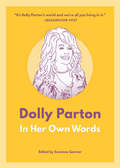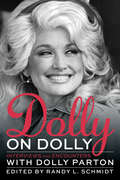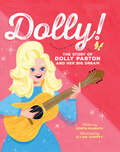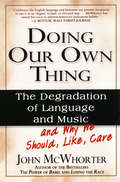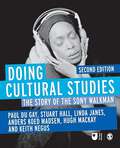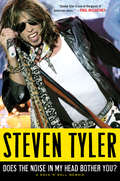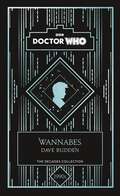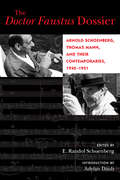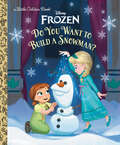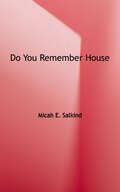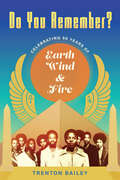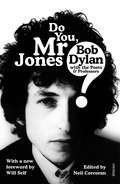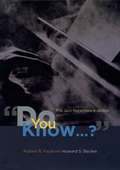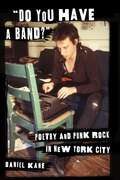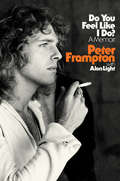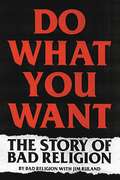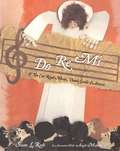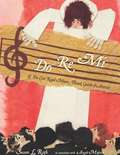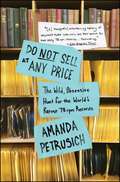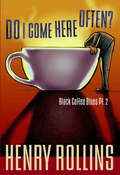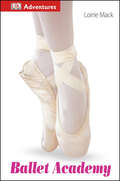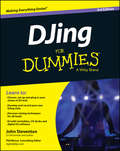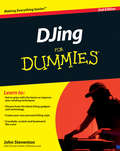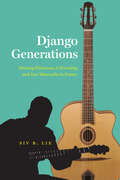- Table View
- List View
Dolly Parton: In Her Own Words (In Their Own Words)
by Suzanne SonnierA collection of quotations from one of America’s most beloved cultural icons.Curated from Dolly Parton’s numerous public statements—interviews, speeches, social media posts, and more—this is a comprehensive picture of her legacy as a musician, businesswoman, and philanthropist. Since her career began in the Nashville music scene of the 1960s, Parton has become revered for her work as a singer, multi-instrumentalist, and songwriter, selling over one hundred million records and being inducted into the Country Music Hall of Fame. And beyond her musical achievements, she co-owns the Dollywood Company and is renowned for the philanthropic work of her Dollywood Foundation.This collection is a look into the inner workings of the woman known for penning such hits as “I Will Always Love You,” “Jolene,” and “9 to 5.” Now, for the first time, you can find Parton’s most inspirational, thought-provoking quotes in one place, providing an intimate and direct look into the mind of this legendary woman.
Dolly on Dolly: Interviews and Encounters with Dolly Parton (Musicians in Their Own Words #12)
by Randy L. Schmidt"Nobody knows Dolly like Dolly," declares Dolly Parton. Dolly's is a rags-to-riches tale like no other. A dirt-poor Smoky Mountain childhood paved the way for the buxom blonde butterfly's metamorphosis from singer-songwriter to international music superstar. The undisputed "Queen of Country Music," Dolly has sold more than 100 million records worldwide and has conquered just about every facet of the entertainment industry: music, film, television, publishing, theater, and even theme parks. It has been more than fifty years since Dolly Parton arrived in Nashville with just her guitar and a dream. Her story has been told many times and in many ways, but never like this. Dolly on Dolly is a collection of interviews spanning five decades of her career and featuring material gathered from celebrated publications including Rolling Stone, Cosmopolitan, Playboy, and Andy Warhol's Interview magazine. Also included are interviews which have not been previously available in print. Dolly's feisty and irresistible brand of humor, combined with her playful, pull-up-a-chair-and-stay-awhile delivery, makes for a fascinating and inviting experience in down-home philosophy and storytelling. Much like her patchwork "Coat of Many Colors," this book harkens back to the legendary entertainer's roots and traces her evolution, stitching it all together one piece at a time.
Dolly!: The Story of Dolly Parton and Her Big Dream
by Robyn McGrathA rhythmically told and vibrantly illustrated picture book biography of Dolly Parton: an American icon beloved by all.You&’ve likely heard of the performer Dolly Parton. But do you know where this dazzling songwriter and musician draws her roots? As one of twelve children growing up in rural Tennessee, Dolly was determined to be seen and heard. From her front porch to her church choir, every stage was an opportunity to perform and share her many talents. While balancing farm chores with schoolwork, Dolly never lost sight of her dreams, composing her first song at age five and performing at the Grand Ole Opry at age thirteen. With lilting language and vibrant artwork, this childhood story captures the unique gifts of Dolly Parton, while also honoring the measures of her success: resilience, confidence, family, and kindness.
Doktor Faustus (ver-)stimmen: Kompositionen zu Thomas Manns Roman
by Anna Maria OlivariIn diesem Open-Access-Buch widmet sich Anna Maria Olivari der Forschungslücke der Vertonung von Thomas Manns Doktor Faustus. Sie untersucht ein Korpus von 13 unterschiedlichen Kompositionen aus dem Bereich der Neuen Musik (Opern, Monodramen, instrumentale Werke), die zwischen 1952 und 2011 entstanden sind und bisher wenig bis gar nicht rezipiert wurden. Thomas Manns Doktor Faustus ist in vielerlei Hinsicht ein breit erforschtes Werk, jedoch nicht in Bezug auf seine Vertonungen. Der Vergleich zwischen Roman und Komposition ist im Forschungsparadigma der Intermedialität angesiedelt und ermöglicht die Rekonstruktion der kompositorischen Rezeptionsgeschichte von Doktor Faustus. Die Rückkopplungseffekte zwischen Text und Musik lassen Thomas Manns Roman neu lesen.
Doing Our Own Thing: The Degradation of Language and Music and Why We Should, Like, Care
by John McWhorterEncourages readers to establish a boundary between an acceptable evolution of language and outright language misuse, predicting the consequences of the overuse of street English in today's writing, music, and society. By the author of The Power of Babel. 50,000 first printing.
Doing Cultural Studies: The Story of the Sony Walkman (Culture, Media and Identities)
by Anders Koed Madsen Hugh Mackay Keith Negus Paul Du Gay Stuart Hall Linda JanesWhy think about the Walkman in the 21st century? Can the Walkman help us understand today’s media and cultural practices? Through the notion of the ′circuit of culture′, this book teaches students to critically examine what culture means, and how and why it is enmeshed with the media texts and objects in their lives.
Does the Noise in My Head Bother You?: A Rock 'n' Roll Memoir
by Steven Tyler"I've been mythicized, Mick-icized, eulogized and fooligized, I've been Cole-Portered and farmer's-daughtered, I've been Led Zepped and 12-stepped. I'm a rhyming fool and so cool that me, Fritz the Cat, and Mohair Sam are the baddest cats that am. I have so many outrageous stories, too many, and I'm gonna tell 'em all. All the unexpurgated, brain-jangling tales of debauchery, sex & drugs, transcendence & chemical dependence you will ever want to hear." The son of a classical pianist straight out of the Bronx of old Archie comics, Steven Tyler was born to be a rock star. Weaned on Cole Porter, Nat King Cole, Mick-and his beloved Janis Joplin-Tyler began tearing up the streets and the stage as a teenager before finally meeting his "mutant twin" and legendary partner Joe Perry. In this addictively readable memoir, told in the playful, poetic voice that is uniquely his own, Tyler unabashedly recounts the meteoric rise, fall, and rise of Aerosmith over the last three decades and riffs on the music that gives it all meaning. Tyler tells what it's like to be a living legend and the frontman of one of the world's most revered and infamous bands-the debauchery, the money, the notoriety, the fights, the motels and hotels, the elevators, limos, buses and jets, the rehab. He reveals the spiritual side that "gets lost behind the stereotype of the Sex Guy, the Drug Guy, the Demon of Screamin', the Terror of the Tropicana." And he talks about his epic romantic life and his relationship with his four children. As dazzling, bold, and out-on-the-edge as the man himself, Does the Noise in My Head Bother You? is an all-access backstage pass into this extraordinary showman's life.
Doctor Who: a 1990s story
by Doctor Who Dave Rudden*Part of the six books for six decades collection*It's Dublin in 1994, and the Doctor and Donna have arrived at the tiny nightclub known as Tripod.Tripod is famous for precisely one thing - the night where four young women came together to make the biggest girl band of the 90s: the Blood Honeys.Donna has convinced the Doctor to visit their first ever concert - and he has begrudgingly agreed.Naturally the band is kidnapped by a deadly pack of siren-like creatures who feed off human adulation, with an eye on taking over the world.With Dublin and the world to save, Donna may get her chance to perform on the world's biggest stage . . .
The Doctor Faustus Dossier: Arnold Schoenberg, Thomas Mann, and Their Contemporaries, 1930-1951 (California Studies in 20th-Century Music #22)
by E. Randol SchoenbergArnold Schoenberg and Thomas Mann, two towering figures of twentieth-century music and literature, both found refuge in the German-exile community in Los Angeles during the Nazi era. This complete edition of their correspondence provides a glimpse inside their private and public lives and culminates in the famous dispute over Mann’s novel Doctor Faustus. In the thick of the controversy was Theodor Adorno, then a budding philosopher, whose contribution to the Faustus affair would make him an enemy of both families. Gathered here for the first time in English, the letters in this essential volume are complemented by diary entries, related articles, and other primary source materials, as well as an introduction by German studies scholar Adrian Daub that contextualizes the impact these two great artists had on twentieth-century thought and culture.
Do You Want to Build a Snowman? (Little Golden Book)
by Golden BooksSing along to the beloved Disney Frozen song &“Do You Want to Build a Snowman?&” with this beautifully illustrated Little Golden Book starring Elsa and Anna!Join Princess Anna as she rides her bike around the castle, talks to paintings on the wall, and asks her sister again and again, &“Do you want to build a snowman?&”. This adorable Little Golden Book features the lyrics of the super catchy Disney Frozen song &“Do You Want to Build a Snowman?&” as well as beautiful images showing the sisters&’ journey throughout the film. It is sure to be a must-have for fans ages 2 to 5 and Little Golden Book collectors of all ages!
Do You Remember House?: Chicago's Queer of Color Undergrounds
by Micah E. SalkindToday, no matter where you are in the world, you can turn on a radio and hear the echoes and influences of Chicago house music. <p><p>Do You Remember House? tells a comprehensive story of the emergence, and contemporary memorialization of house in Chicago, tracing the development of Chicago house music culture from its beginnings in the late '70s to the present. Based on expansive research in archives and his extensive conversations with the makers of house in Chicago's parks, clubs, museums, and dance studios, author Micah Salkind argues that the remediation and adaptation of house music by crossover communities in its first decade shaped the ways that Chicago producers, DJs, dancers, and promoters today re-remember and mobilize the genre as an archive of collectivity and congregation. The book's engagement with musical, kinesthetic, and visual aspects of house music culture builds from a tradition of queer of color critique. As such, Do You Remember House? considers house music's liberatory potential in terms of its genre-defiant repertoire in motion. <p><p>Ultimately, the book argues that even as house music culture has been appropriated and exploited, the music's porosity and flexibility have allowed it to remain what pioneering Chicago DJ Craig Cannon calls a "musical Stonewall" for queers and people of color in the Windy City and around the world.
Do You Remember?: Celebrating Fifty Years of Earth, Wind & Fire (American Made Music Series)
by Trenton BaileyIn Do You Remember? Celebrating Fifty Years of Earth, Wind & Fire, Trenton Bailey traces the humble beginning of Maurice White, his development as a musician, and his formation of Earth, Wind & Fire, a band that became a global phenomenon during the 1970s. By the early 1980s, the music industry was changing, and White had grown weary after working constantly for more than a decade. He decided to put the band on hiatus for more than three years. The band made a comeback in 1987, but White’s health crisis soon forced them to tour without him. During the twenty-first century, the band has received numerous accolades and lifetime achievement and hall of fame awards. The band remains relevant today, collaborating with younger artists and maintaining their classic sound. Earth, Wind & Fire stood apart from other soul bands with their philosophical lyrics and extravagant visual art, much of which is studied in the book, including album covers, concerts, and music videos. The lyrics of hit songs are examined alongside an analysis of the band’s chart success. Earth, Wind & Fire has produced twenty-one studio albums and several compilation albums. Each album is analyzed for content and quality. Earth, Wind & Fire is also known for using ancient Egyptian symbols, and Bailey thoroughly details those symbols and Maurice White’s fascination with Egyptology. After enduring many personnel changes, Earth, Wind & Fire continues to perform around the world and captivate diverse audiences.
Do You Mr Jones?: Bob Dylan with the Poets and Professors
by Neil CorcoranIn 2016, Bob Dylan received the Nobel Prize in Literature ‘for having created new poetic expressions within the great American song tradition’. This collection of essays by leading poets and critics – with a new foreword by Will Self – examines Dylan’s poetic genius, as well as his astounding cultural influence over the decades.‘From Orpheus to Faiz, song and poetry have been closely linked. Dylan is the brilliant inheritor of the bardic tradition’ Salman Rushdie‘The most significant Western popular artist in any form or medium of the past sixty years’ Will Self‘For fifty and some years he has bent, coaxed, teased and persuaded words into lyric and narrative shapes that are at once extraordinary and inevitable’ Andrew Motion‘His haunting music and lyrics have always seemed, in the deepest sense, literary’ Joyce Carol Oates‘There is something inevitable about Bob Dylan… A storyteller pulling out all the stops – metaphor, allegory, repetition, precise detail… His virtue is in his style, his attitude, his disposition to the world’ Simon Armitage
"Do You Know...?": The Jazz Repertoire in Action
by Robert R. Faulkner Howard S. BeckerEvery night, somewhere in the world, three or four musicians will climb on stage together. Whether the gig is at a jazz club, a bar, or a bar mitzvah, the performance never begins with a note, but with a question. The trumpet player might turn to the bassist and ask, "Do you know 'Body and Soul'?"-and from there the subtle craft of playing the jazz repertoire is tested in front of a live audience. These ordinary musicians may never have played together-they may never have met-so how do they smoothly put on a show without getting booed offstage. In "Do You Know . . . ?" Robert R. Faulkner and Howard S. Becker-both jazz musicians with decades of experience performing-present the view from the bandstand, revealing the array of skills necessary for working musicians to do their jobs. While learning songs from sheet music or by ear helps, the jobbing musician's lexicon is dauntingly massive: hundreds of thousands of tunes from jazz classics and pop standards to more exotic fare. Since it is impossible for anyone to memorize all of these songs, Faulkner and Becker show that musicians collectively negotiate and improvise their way to a successful performance. Players must explore each others' areas of expertise, develop an ability to fake their way through unfamiliar territory, and respond to the unpredictable demands of their audience-whether an unexpected gang of polka fanatics or a tipsy father of the bride with an obscure favorite song. "Do You Know . . . ?" dishes out entertaining stories and sharp insights drawn from the authors' own experiences and observations as well as interviews with a range of musicians. Faulkner and Becker's vivid, detailed portrait of the musician at work holds valuable lessons for anyone who has to think on the spot or under a spotlight.
"Do You Have a Band?": Poetry and Punk Rock in New York City
by Daniel KaneDuring the late 1960s, throughout the 1970s, and into the 1980s, New York City poets and musicians played together, published each other, and inspired one another to create groundbreaking art. In "Do You Have a Band?", Daniel Kane reads deeply across poetry and punk music to capture this compelling exchange and its challenge to the status of the visionary artist, the cultural capital of poetry, and the lines dividing sung lyric from page-bound poem.Kane reveals how the new sounds of proto-punk and punk music found their way into the poetry of the 1960s and 1970s downtown scene, enabling writers to develop fresh ideas for their own poetics and performance styles. Likewise, groups like The Fugs and the Velvet Underground drew on writers as varied as William Blake and Delmore Schwartz for their lyrics. Drawing on a range of archival materials and oral interviews, Kane also shows how and why punk musicians drew on and resisted French Symbolist writing, the vatic resonance of the Beat chant, and, most surprisingly and complexly, the New York Schools of poetry. In bringing together the music and writing of Richard Hell, Patti Smith, and Jim Carroll with readings of poetry by Anne Waldman, Eileen Myles, Ted Berrigan, John Giorno, and Dennis Cooper, Kane provides a fascinating history of this crucial period in postwar American culture and the cultural life of New York City.
Do You Feel Like I Do?: A Memoir
by Peter FramptonA revelatory memoir by rock icon and legendary guitarist Peter Frampton.Do You Feel Like I Do? is the incredible story of Peter Frampton's positively resilient life and career told in his own words for the first time. His monu-mental album Frampton Comes Alive! spawned three top-twenty singles and sold eight million copies the year it was released (more than seventeen million to date), and it was inducted into the Grammy Hall of Fame in January 2020. <P><P>Frampton was on a path to stardom from an early age, first as the lead singer and guitarist of the Herd and then as cofounder -- along with Steve Marriott -- of one of the first supergroups, Humble Pie. Frampton was part of a tight-knit collective of British '60s musicians with close ties to the Rolling Stones, the Beatles, and the Who. This led to Frampton playing on George Harrison's solo debut, All Things Must Pass, as well as to Ringo Starr and Billy Preston appearing on Frampton's own solo debut. By age twenty-two, Frampton was touring incessantly and finding new sounds with the talk box, which would become his signature guitar effect. <P><P>Frampton remembers his enduring friendship with David Bowie. Growing up as schoolmates, crossing paths throughout their careers, and playing together on the Glass Spider Tour, the two developed an unshakable bond. Frampton also shares fascinating stories of his collaborative work with Harry Nilsson, Stevie Wonder, B. B. King, and members of Pearl Jam. He reveals both the blessing and curse of Frampton Comes Alive!, opening up about becoming the cover boy he never wanted to be, his overcoming sub-stance abuse, and how he has continued to play and pour his heart into his music despite an inflammatory muscle disease and his retirement from the road. <P><P>Peppered throughout his narrative is the story of his favorite guitar, the Phenix, which he thought he'd lost in a fiery plane crash in 1980. But in 2011, it mysteriously showed up again -- saved from the wreckage. Frampton tells of that unlikely reunion here in full for the first time, and why the miraculous reappearance is emblematic of his life and career as a quintessential artist. <P><P><b>A New York Times Bestseller</b>
Do What You Want: The Story of Bad Religion
by Bad ReligionFrom their beginnings as teenagers experimenting in a San Fernando Valley garage dubbed "The Hell Hole" to headlining major music festivals around the world, Do What You Wanttells the whole story of Bad Religion's 40-year career in irreverent style. Do What You Want: The Bad Religion Story reveals the ups and downs of the band's forty-year career. From their beginnings as teenagers jamming in a San Fernando Valley garage dubbed "The Hell Hole" to headlining major music festivals around the world, Do What You Want tells the whole story in irreverent style.While Do What You Want tracks down nearly all of Bad Religion's members past and present, the chief storytellers are the four voices that define Bad Religion: Greg Graffin, a Wisconsin kid who sang in the choir and became an L.A. punk rock icon while he was still a teenager; Brett Gurewitz, a high school dropout who founded the independent punk label Epitaph Records and went on to become a record mogul; Jay Bentley, a surfer and skater who gained recognition as much for his bass skills as for his onstage antics; and Brian Baker, a founding member of Minor Threat who joined the band in 1994 and brings a fresh perspective as an intimate outsider. With a unique blend of melodic hardcore and thought-provoking lyrics, Bad Religion paved the way for the punk rock explosion of the 1990s, opening the door for bands like NOFX, The Offspring, Rancid, Green Day, and Blink-182 to reach wider audiences. They showed the world what punk could be, and they continue to spread their message one song, one show, one tour at a time -- with no signs of stopping.
Do Re Mi
by Angelo Mafucci Susan L. RothIf you can read musical notes, you can sing any song or play any piece. But musical notes have not always been here. Long ago, songs were memorized. If songs were forgotten, they were lost forever. Thanks to one man, Guido d’Arezzo, music now can last forever.
Do Re Mi: If You Can Read Music, Thank Guido d'Arezzo
by Susan L. RothIf you can read musical notes, you can sing any song or play any piece. But musical notes have not always been here. Long ago, songs were memorized. If songs were forgotten, they were lost forever. Thanks to one man, Guido d’Arezzo, music now can last forever.
Do Not Sell At Any Price
by Amanda PetrusichThe untold story of a quirky and important subculture: The world of 78rpm records and the insular community that celebrates them--by acclaimed music critic and author Amanda Petrusich, who contributes regularly to Pitchfork, The Oxford American, and The New York Times.Before MP3s, CDs, and cassette tapes, even before LPs or 45s, the world listened to music on 78rpm records--those fragile, 10-inch shellac discs. While vinyl records have enjoyed a renaissance in recent years, good 78s are exponentially harder to come by and play. A recent eBay auction for the only known copy of a particular record topped out at $37,100. Do Not Sell at Any Price explores the rarified world of the 78rpm record--from the format's heyday to its near extinction--and how collectors and archivists are working frantically to preserve the music before it's lost forever. Through fascinating historical research and beguiling visits with the most prominent 78 preservers, Amanda Petrusich offers both a singular glimpse of the world of 78 collecting and the lost backwoods blues artists whose 78s from the 1920s and 1930s have yet to be found or heard by modern ears. We follow the author's descent into the oddball fraternity of collectors--including adventures with Joe Bussard, Chris King, John Tefteller, Pete Whelan, and more--who create and follow their own rules, vocabulary, and economics and explore the elemental genres of blues, folk, jazz, and gospel that gave seed to the rock, pop, country, and hip-hop we hear today. From Thomas Edison to Jack White, Do Not Sell at Any Price is an untold, intriguing story of preservation, loss, obsession, art, and the evolution of the recording formats that have changed the ways we listen to (and create) music.
Do I Come Here Often?
by Henry RollinsDo I Come Here Often? includes interviews with Jerry Lee Lewis and Isaac Hayes, articles on Roky Erickson and David Lee Roth and Rollins' 1991 Lollapalooza tour journals and features illustrations by Shannon Wheeler ("Too Much Coffee Man").
DK Adventures: Ballet Academy (DK Adventures)
by Lorrie MackLucy follows her dream to train to be a professional ballerina, and is selected as one of a handful of students into the Ballet Academy. Follow her journey as she gets through the tough training with the support of teachers and fellow students, and performs alongside her idol in The Nutcracker before facing her final challenge of getting into Ballet High School. DK Adventures are an innovative mix of narrative and nonfiction for kids ages 8-11 featuring engaging, action-packed stories that help kids build their skills in vocabulary, grammar, comprehension, and critical thinking while developing a love of reading. With diaries, recipes, poetry, instructions, graphics, or songs, the genre spreads in each DK Adventures title enhance the story and reinforce curriculum learning, while the expansive range of entertaining nonfiction subjects will appeal to boys and girls everywhere. Supports the Common Core State Standards.
DJing For Dummies (For Dummies Ser.)
by John SteventonDJ like a pro—without skipping a beat The bestselling guide to spinning and scratching is back! If you've ever spent hours in your bedroom with two turntables and an earful of tracks that sound off-beat or out of key, DJing For Dummies is the go-to guide for taking your skills to the next level. Inside, John Steventon, a successful club DJ, walks you through the basics of mixing, the techniques and tricks you need to create your own DJ style and how to make DJing work for you. Covering both digital and old-school vinyl-based instruction, this guide covers all the latest DJ technology, equipment and software so you can get mixing and stay one step ahead of the crowd. Brimming with expert advice and easy-to-follow explanations, the information in DJing For Dummies gives you everything you need to build a foolproof set and play to a live crowd. Nail down the basics and build on existing skills Sort through the latest equipment and technology Have a go at crossfading, beatmatching and scratching Mix tracks seamlessly to sound like a pro If you're new to the game or looking to step up your skills and graduate to club work, DJing For Dummies has you covered.
DJing For Dummies
by John SteventonHow to start and build a successful career as a DJ-from at-home mixing to making demos to playing to a live crowdWhether it's a digital or vinyl track of "Proud Mary," a DJ sets the mood, amps up the excitement, and gets a crowd of revelers rockin'. Often an outsized personality, blessed with a gorgeous voice and an encyclopedic knowledge of music, a DJ is this era's new pop star. For those interested in how to begin a career as a DJ, DJing For Dummies offers newcomers all the technical know-how needed as well as advice on how to create your own DJing style and how to make DJing work for you. With tips on equipment essentials, such as turntables, slipmats and needles, headphones, and amplifiers, as well as buying records, CDs, and MP3s, this practical guide takes you through the basics of mixing, song structure, building a foolproof set, creating a great demo, and what to do when you finally face a live audience.Includes ten resources for expanding your skills and fan baseWith invaluable advice on ten DJing mistakes to avoid as well as answers to DJ questions you're too afraid to askIncludes updated info on the latest software and techniques, expanded content on digital DJing, and DJing over the InternetWith tips on the ten items to take with you when you get a gig, as well as how to DJ at a wedding, DJing For Dummies will help turn your fantasy into an exciting and fun, money-making career.
Django Generations: Hearing Ethnorace, Citizenship, and Jazz Manouche in France (Chicago Studies in Ethnomusicology)
by Siv B. LieDjango Generations shows how relationships between racial identities, jazz, and national belonging become entangled in France. Jazz manouche—a genre known best for its energetic, guitar-centric swing tunes—is among France’s most celebrated musical practices of the twentieth and twenty-first centuries. It centers on the recorded work of famed guitarist Django Reinhardt and is named for the ethnoracial subgroup of Romanies (also known, often pejoratively, as “Gypsies”) to which Reinhardt belonged. French Manouches are publicly lauded as bearers of this jazz tradition, and many take pleasure and pride in the practice while at the same time facing pervasive discrimination. Jazz manouche uncovers a contradiction at the heart of France’s assimilationist republican ideals: the music is portrayed as quintessentially French even as Manouches themselves endure treatment as racial others. In this book, Siv B. Lie explores how this music is used to construct divergent ethnoracial and national identities in a context where discussions of race are otherwise censured. Weaving together ethnographic and historical analysis, Lie shows that jazz manouche becomes a source of profound ambivalence as it generates ethnoracial difference and socioeconomic exclusion. As the first full-length ethnographic study of French jazz to be published in English, this book enriches anthropological, ethnomusicological, and historical scholarship on global jazz, race and ethnicity, and citizenship while showing how music can be an important but insufficient tool in struggles for racial and economic justice.
